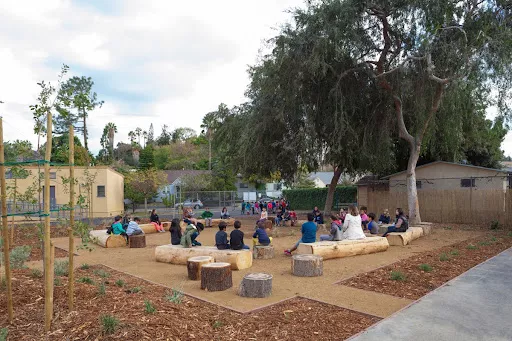
By Amanda Stemen
One of the things that stood out most when I first moved to the Los Angeles area, as both an educator and an outdoor recreation professional, was the lack of green on public school campuses. Growing up in Michigan, and then working in Atlanta, GA, I was used to nature being right out the door. Fortunately, I wasn’t the only one with concerns. In response to the large number of schoolyards made of asphalt and concrete – and their resulting negative impact on health, equity, and climate resilience – the LA Living Schoolyards Coalition (LSYC) was founded in 2019.
The Living Schoolyards Coalition consists of nonprofit organizations, educators, and community members, including the Sierra Club, who create and advocate for equitable school environments that support physical and mental health, social and emotional well-being, safe outdoor education, access to nature, and climate resilience for Los Angeles County’s public-school students and communities. This is accomplished through community-led efforts to transform schoolyards across the district into beautiful, green spaces that reflect the unique needs of the students, families, and communities they serve.
LAUSD is being given $300 million from Measure RR (the School Upgrades and Safety Measure) to upgrade, modernize and replace aging and deteriorating school facilities. In planning for how these funds will be used, LSYC is advocating LAUSD adopt a resolution to update district design guidelines to support comprehensive school greening. This resolution is meant to be permanent practice for the district, and includes: the integration of greening into any planned repairs; the use of shade trees and other native, drought-tolerant plant life to reduce heat; replacing pavement with natural, permeable surfaces; capturing rainwater; as well as other greening efforts in the outdoor areas where students spend time. The goal is for students and teachers to easily access shaded areas for play and for use as outdoor, experiential learning. The resolution also calls for the development of metrics to measure and keep track of progress toward: greening goals, streamlining and removing barriers to green campuses, and ensuring that these efforts are first made in historically underserved communities which are most vulnerable to extreme heat.
The ultimate goal is to have all the green schoolyards open to the public during non-school hours, and to provide opportunities for every child and community member to thrive, play, engage, and explore. Opening campuses to the community during non-school hours has been shown to boost student academic achievement and enrollment by providing school-civic linkages, increasing parent involvement at school, and deterring crime. Moreover, access extends the benefits of open space to the children, families and neighbors who reside in the surrounding community, contributing to green space and health equity in areas of high need. For more information: see the Living Schoolyards website.
Amanda Stemen’s life has always revolved around nature and she currently works as a licensed ecotherapist (nature-based mental health therapist), as well as volunteers with the Central Group as its Parks Committee Chairperson.